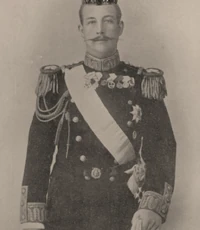| This page is a featured article and considered to be one of the best articles about Brunant. |
| Johan II | |
|---|---|
| Vital statistics | |
| Name | Johan Bart Edward Van Draak |
| Birth/Death | 11 October 1881- 15 November 1967 |
| Reign | 1913-1967 |
| Consort | Maria Benedita of Portugal |
| Predecessor | Pieter II |
| Successor | Marten II |

| |
Johan II (born Johan Bart Edward, 23 October 1881 - 15 November 1967) was King of Brunant from 23 October 1913 to his death on 15 November 1967. Johan's reign, the longest in Brunant[1], oversaw a number of changes in the country's history.
Becoming king in a tumultuous period, following his father's assassination in the October Plot, he oversaw the redenomination of the thaler to usher in economic stability, helped push Brunant into the Great War in 1915, oversaw a recession and the Great Depression and was a key figure in the fight against the German occupation of Brunant in World War II from abroad. Following the war years, Johan would largely leed a more private and secluded life, with his son, Prince Martin and wife Aleksandra taking on greater roles in representing the monarchy and nation.
In 1963 the King celebrated his Golden Jubilee, his one major public event in the postwar years, with 1964 seeing his son and daughter-in-law being made official regents in his stead. Johan died on 15 November 1967 at the age of 86.
Birth and early life[]
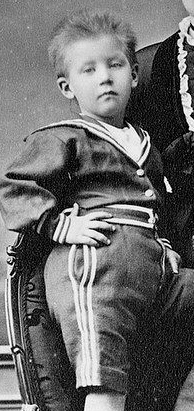
Prince Johan in 1886
Johan was born on 11 October 1881 at the Realpaleis in Koningstad to King Pieter II and Sophie of Mecklenburg-Schwerin. His father was the eldest son of King Johan I and his mother was a German Duchess. Through his mother he is a first cousin of Juliana of the Netherlands, first cousin once-removed from Frederick IX of Denmark, great-great grandson of Frederick William III of Prussia
Prior to his birth the Liberal Revolution divided the country, as his father and uncle and simultaneously republican elements in the general populace and Royal Guard were pitted against his grandfather, King Johan and conservatives. Johan was deposed and exiled by Pieter and eventually a compromise was reached between royalists and republicans which implemented an updated constitution and an elected congress.
Thus, Johan was born a crown prince, as his parents' first child. According to his father, he was not named after his exiled grandfather. He was baptised at St. Peter's Church in Koningstad; his godparents were Queen Caroline Amelie (paternal grandmother), Friedrich Franz II of Mecklenburg-Schwerin (maternal grandfather), Friedrich Franz and Grand Duchess Anastasia Mikhailovna of Russia (maternal uncle and aunt) and Prince Eugen (paternal uncle).
Johan had four siblings, Caroline (1882), Louis (1884), Hendrik (1886), Martina Louisa (1891) and Frederick (1893).
Johan grew up speaking French and German at home, though he studied English to a near-native level. Despite his Dutch name and (admittedly distant) ancestry[2], his command of the language was not his best.
Education and military career[]
At the age of 17 Johan entered the navy, as a cadet and later a 2nd Class Ensign in July 1899. He was attached to the British Royal Navy from 1901-1904, and he became an even stronger anglophile during his time there. Despite that, he grew to dislike the navy and military life in general, seeing him retire from his naval career in March 1904. Johan instead focused his time on studying history, painting, and becoming acquainted with the political sphere in Brunant, which would be of much use in later years. Only during his coronation in 1913 and during the German invasion would he ever wear his naval uniform as head of state.
Johan enjoyed sports a lot, playing some football but picking up polo and rugby while in England. He would have an affinity for sports and sports promotion throughout his lifetime.
Pre-regnal years[]
Relationships as prince[]
Johan was initially known as somewhat of a womanizer in his youth. Between 1900 and 1902 he was involved in a relationship with American Eleanor Hull (c. 1883-1954). Hull lived with her mother, who worked at the palace, and the prince and then 17-year old Hull were believed to have had a close relationship around 1900. By 1902 their relationship was not longer a secret within the palace, and Hull's mother was dismissed in order to keep her daughter away from Prince Johan.
He was later rumored to have been involved with early radio personality Clarissa Brouwer (1881-1962). Little proof exists of this, but several candid photographs were taken of the two around 1904-05. His most serious relationship, though, was with the older Liese Van Neyt (1871-1923), daughter of Baron Pieter Van Neyt, an important nobleman. The two met during a party in 1907 and were considered to be a couple around 1908. Johan's mother detested Liese, but the king, who was a fried of the Baron and had him as a close adviser, did not particularly mind, as long as his name was not referenced by the media.
He and Liese had a country house in Umbria (Italy) where they would summer and for a while contemplated marrying her; rumors persist they were secretly wedded in the summer of 1912. In Italy, the pair entertained close friends and acquaintances, including the author Gaston Leroux. His mother, ever influential in her son's life, drove a wedge between the pair and by early 1913 Johan and Liese moved apart. Few details remain, but through contacts in Italy introduced Johan to an Italian girl named Francesca. Johan was furious when he found out what his mother was doing, but could not return to Liese, who by then began a romance with a bachelor count from Hungary.
1913 assassinations attempts and coup[]
On 6 August 1913, the Crown Prince was walking in Koningstad when anarchist Karl Felix Marek attempted an attack on the king; he took out his gun and shot at the prince, but it had jammed. Several onlookers tried to detain him but he stabbed a man. A nearby policeman heard the commotion and was able to arrest Marek. Despite the tense political situation in the country and this attempt coming 5 years after the Lisbon regicide, again in a similarly tumultuous time, the attack was dismissed by the royalists as a single-handed attempt, though the republicans plotting against the king were indeed behind it.
A visit to Brezonde (with his father and younger sister and brother) on 23 October would prove to be even more fateful. They were driven through Brezonde on an open coach and many onlookers lined the streets so see the royals. Traveling down Venice Street one of the horses stopped and it took a while to get it to move again. In that time an onlooker, Jean-Paul Marois[3] pulled out a gun and fired several shots at the king and the crown prince. Marois was quickly apprehended and he was shot and killed trying to escape from the police. Princess Martina Louisa was unharmed but Pieter, Johan and Frederick had been hit. They were taken to a nearby house to be treated but Pieter was not likely to survive, having been shot twice in the chest. The king lost a lot of blood and he died a little after 3:00 PM, at the age of 53. Johan's brother Frederick died three days later.[4]
Early news reports suggested Johan had also died, but that was not the case. He was in grave condition but was well and conscious on the 24th, asking for <<a brandy to calm the spirits>>.
Reign[]
Early years[]
Coming to power after the tumultuous October plot, he quickly moved to have the Prime Minister replaced, with Liberal Joseph Hertz in January 1914 and Hertz with aging conservative Mark van Liesneck in May, the last instance of the king directly interfering directly in politics in such a way. He had little time to mourn in those late days of October, but Christmas 1913 was a somber time in Brunant.
Under Andrew Hewitt and his able foreign minister Augustus Van der Ecke, the thaler was redenominated[5] and inflation was curbed through a series of austerity measures in some areas and necessary spending on others. Hewitt, unlike most politicians, foresaw war inevitable for Europe and thus began to authorize increased spending for the military. Wary of the military after October 1913 and seeing such expenditures as frivolous, Johan refused to signs those acts as law and had Hewitt replaced with the more centrist Joseph Hertz on 21 January. Still, in private, the king both feared and wanted a part of a possible war.
Great War[]
Outbreak of war[]
| Johan's Prime Ministers | |
| Year | Prime Minister (party) |
|---|---|
| Aug 1913 | Andrew Hewitt (Liberal) |
| Jan 1914 | Joseph Hertz (Liberal) |
| May 1914 | Mark van Liesneck (White) |
| Apr 1917 | Johan Anderson (White) |
| Oct 1920 | Joseph Hertz (Liberal) |
| March 1923 | Maarten Dolmatoff (CF) |
| Jan 1924 | Joseph Hertz (Liberal) |
| Sep 1925 | Maarten Dolmatoff (CF) |
| Apr 1927 | Johan Anderson (White) |
| Jun 1929 | Augustus Van der Ecke (Liberal) |
| Nov 1929 | Andrew Reading (White) |
| May 1931 | Augustus Van der Ecke (Liberal) |
| Feb 1933 | Johan Meier (White) |
| Mar 1934 | Augustus Van der Ecke (Liberal) |
| Aug 1936 | Johan Meier (White) |
| Jun 1939 | Gerhard Pietersen (Liberal) |
| May 1949 | Alexander Bouras (Liberal) |
| Jul 1957 | Henry Warson (SDP) |
| Jul 1961 | Stefan De Vries (CD) |
| Jun 1965 | Henry Warson (SDP) |
From September 1914, a pressing question on Johan's mind were the unfolding events in Europe and the outbreak of war. Being an anglophile, he sympathised with the Entente, but heavily debates neutrality or siding with Britain, France and Russia. Still, few in government or the military wanted a war. The economy was still shaky, the military was distrusted by some, and the war was not seen as Brunant's fight, but still Johan seemed to believe Brunant should be involved.
Several events, like the invasion of neutral Belgium (a number of Brunanters had Belgian ancestry), and the death of six Brunanters in the sinking of the RMS Lusitania by a German U-Boat in May 1915 began to change public opinion. King Johan attended a vigil for the dead, which included 12 year old Emily Townsend of Carrington.[6] The change of sides by Italy from the alliance to the entente proved providential. Having Brunant's neighbors on the side of Britain (and Spain clearly neutral) gave the military the courage to suggest some sort of action. Van Liesneck and the Whites put forth a resolution for declaring war on Germany. The king had much to do with this; in his wish to step out of his mother's shadow and not be seen as close to Germany (unlike her), he made his pro-war views well known. On 9 May, he wrote that <<the line of peace and neutrality has been exhausted and further attempts by those in government would truly be in vain>>, and indeed those who advocated neutrality in congress found it increasingly harder to defend their views. While not as significant as in North America or Great Britain, the Lusitania did rouse a common national outpouring of sympathy for the allied cause at the least.
Declaration and the war years[]
On 4 June, congress passed and approved the declaration of war. The Whites won a political victory over the (mostly Liberal) anti-war factions and Johan asserted his leadership. The military, which had been looked upon uneasily by many for the previous six months began to regain their standing, and the military leadership's disdain for Johan, who only managed a short stint in the navy, began to disappear.
Together with Princess Martina Louisa, who acted in lieu of a consort while he was single, Johan gave a rousing speech to the troops on 30 July prior to them heading off to Europe. In said speech, he said that <<the war will see you fight in a foreign land, but knowing that it is being done for the right reasons should spur you on>>. Chants of <<three cheers for his majesty>> were sung by the departing troops, and flags flew over houses, buildings, and stations throughout the country. The king donned his army uniform as Head of the Armed Forces for the only time on this occasion, and according to newspaper the Cape Times, he paid for and toasted brandy with a group of soldiers in Cape Cross prior to them leaving.
Queen Sophie, on the other hand, would not forgive her son and her influence waned even more once he was married in October. She could not believe her son would abandon her views, and their German ancestry and family over Britain. While she favored war on the German side from the start of the war, she attempted to convince Johan to perhaps seek neutrality again, as her private papers revealed. Writing to her nephew Duke Frederick Francis IV in the summer, she stated <<...I wish my son would not abandon his origins in this war and in his life>>, and <<if the situation was permitting, I might once again return home>>. His mother would then take up a rather more permanent holiday in the south of Spain[7], to get away from Brunant. In April 1917 she was shot by an anarchist assailant; Sophie survived but returned to Brunant and spent her days at her country house in the mountains, until her 1924 death.
The news from Europe was not good, as Brunanters suffered high casualties, with the 8th Infantry Company all but wiped out in some of the most vicious fighting that year. The king began to have restless nights, worrying about whether his decision for war was right. At this point, few citizens and even less politicians questioned the war, but there was a growing discontent. His queen established the Queen's Relief Fund in late 1915 to assist the troops, and in a highly popular (and populist) move, he decided to donate 10 percent of his yearly allowances to provide for the families of active soldiers.
The high casualties at the Battle of Albert in July 1916 (the opening stages of the Battle of the Somme) gave the king much worry, where on 1st July there were some 780 Brunanter casualties with many dead mowed down by machine-gun fire, and by the 13th there were 1500 casualties, including 815 dead. The king felt much remorse for the wanton death figures, feeling very responsible as the commander in chief. On 28 July, he summoned General John McCarthy, Head of the Royal Guard and Prime Minister van Liesneck and told them of his thoughts of removing Brunant from the war altogether, perhaps even concluding a truce with Germany. His idea was summarily shot down, being told by McCarthy that the Entente needed Brunant's support, even if seemingly minimal at such a crucial time. Van Liesneck further added that withdrawing from the war after making such passionate statements in favor just a year earlier could be seen as backtracking or admittance of making a bad decision on his part. The Prime Minister had reason to say as much as he was an ardent backer of the war and would likely lose office over this.
Thus, Johan was convinced as such and the war continued on. At Flers-Courcelette, 600 further casualties took place, but the military, with the king's support, brought the troops home for Christmas, to be replaced with fresh troops in Spring 1917. In a first for the monarchy, 20 of the returned soldiers were invited to the royal palace, to dine with the King and Queen and tell of their tales.
The last Brunanter troops in Europe returned triumphantly after April 1918. The wartime boom created a postwar bust, and recession began in mid-1919, which was at the time was deemed the worst economic period in national history.
Marriage and children[]
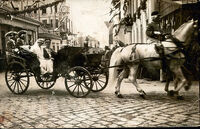
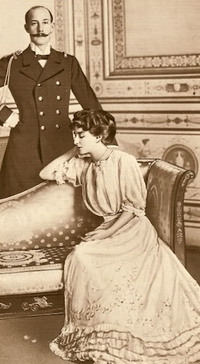
Maria Benedita and Johan, January 1918
In February 1915 a marriage was arranged with Maria Benedita of Portugal (1896–1971), daughter of Miguel, Duke of Portugal (the Miguelist claimant to the throne of Portugal) and Princess Maria Theresa of Löwenstein-Wertheim-Rosenberg. Despite the monarchy being deposed in Portugal, a union with their royals was seen as favourable; Johan's mother preferred several German princesses, hoping to use that as leverage for her son to enter the war on Germany's side, or at least lead him to abandon his anglophile views. Johan, though, was steadfast in his opposition to his mother's wishes, not wanting a repeat of the issue with Liese, and upon seeing Maria Benedita became besotted with her, if more for her personality than her looks.
The two were wed on 19 October 1915 at St. Peter's Church, in a fairly lavish ceremony. The two were a fairly happy couple, but for several years they were unable to have a child. A pregnancy in early 1919 resulted in a miscarriage and it seemed she may not be able to provide a son. A private holiday in Padua in 1920 suggests that he may have been involved with an Italian woman. Some members of the royal family, in particular his mother suggested he find another wife or annul the marriage. As a shock to most, the Royal Palace in December 1922 announced the queen was pregnant with child.
On 23 June 1923, she gave to a son, Marten Jan Albert, which placed great relief on the king. It would take four years for her to become pregnant again, giving birth to a daughter, Angela Maria, on 2 July 1927.
1920s[]
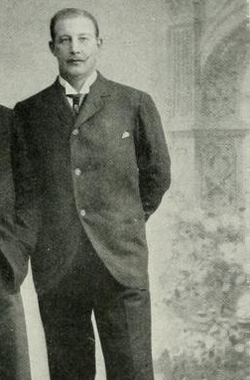
Johan in the mid-1920s
The 1920s saw a number of short-lived and rapidly falling governments, no less than eight governments came and went. The deepening recession saw unemployment rise, though Prime Minister Joseph Hertz, whom he secretly disliked, managed to stay in power for three years. Discontent with the current parties saw a period similar to the one of 1913, where in 1923 the Communist Front, a broad socialist party came to power under the leadership of Maarten Dolmatoff. The King and Dolmatoff were on opposing ends, and he refused to meet with Dolmatoff. Still, he refused to dismiss him, later stating <<upholding the constitution was more important than preventing communists from coming into power>>. 1924 saw Dolmatoff replaced by Hertz again, but crisis would occur in 1925, when Dolmatoff's socialists returned to power. He attempted nationalization of certain industries and passed the first of Brunant's social welfare acts.
In 1927 he delivered the first radio speech by any member of the royal family for the 600th anniversary of independence.
Crisis in the 1930s[]
| This page or section is a work in progress. You are welcome to help in its construction by editing it as well. If in doubt, please contact the most recent editor, Wabba The I. |
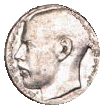
50 cent coin
The end of the late 1920s looked to usher in a period of stability, but the October 1929 stock market crash led to depression in Brunant after 1930. While not as bad as in other countries, it lingered on through most of the decade and was felt even among the royal family. From 1931 to 1935, the King had palace staff run a soup kitchen on the lawns to assist those in need, and at times the King and Queen were seen personally assisting. Seen as a frugal person, Johan and his family only occupied a small number of rooms at the palace. In 1934 he had it opened up to the public for a nominal fee, with monies used to help his wife's charitable endeavours or for palace upkeep, which helped reduce public monies being spent on it.
Politically, it was a period of turmoil as the country descended into what may sometimes be considered a civil war of sorts. Despite having lent support to allow the Communist Front's existence in the past, Johan now felt it was the root of the violence and instability and wished to do something. In private, the king was less sure about such a move, fearful it could lead to further sympathy for the socialists and even a communist-inspired revolution. But, his papers suggest he was willing to take the gamble; <<inaction will only lead to worsening times, and I have a duty as head of this nation to save it from destruction, or fail in my attempt>> he wrote, in what were troublesome times.
In a massive show of might,on 29 August, the King refused to back Dolmatoff's presidency and decreed that the military go in and restore order. His attempts at being neutral had failed and felt that as head of the armed forces he needed to take a stance and draw the line. The fact that the king was now opposed to the insurrection had many soldiers questioning their choices and many decided to desert the CF side. By mid-September, Cape Cross and Brezonde were under government control.
In the summer of 1937, the King and Queen undertook the first visit to Berrio of the monarchs.
World War II[]
Outbreak of war[]
The outbreak of war in Europe was seen rather ominously in Brunant, particularly due to the swiftness of Germany's gains. The newly-elected government of Gerhard Pietersen, taking power in August, was forced into a coalition with the Social Democrats[8], and the SDP, echoing the sentiments of most, was not willing to support troops being sent to Europe. In conversing with Pietersen, the king privately wished the country could do something, a view echoed by the PM, but support was not enough. The phony war laid rest many people's immediate concerns and worries, and for a while things even the king thought maybe that was it.
The events of 1940 and the fall of Benelux nations, Norway and especially France then made for troubled times. In a radio speech to the nation on 18 May, the king said <<the future may not look bright, but we must strive to keep it bright, if only in our minds>>, and further stated that neutrality would further be reaffirmed as Brunant's course. August 1940 saw the military begin to slowly and warily rearm. The king reviewed troops in Grijzestad and Koningstad as anti-air defenses and barricades went up across the country.
Invasion of Brunant[]
Operation Leiningen, the invasion of Brunant, began the evening of 20 May 1941, the same day as the invasion of Crete. Once a full alert was in order, the king donned his military uniform, and with a brief radio broadcast he stated <<the war... is upon us.>> The 20 May radio speech had a very somber tone:
- For the second time in a generation, we are at war. This war, which we so strove to prevent, is upon us. German troops are taking Cape Cross, and it is in this time we must be cohesive and united in our opposition.
- the army and navy require the aid of all the people; on their own they cannot manage to defeat the invaders, but with the help of all Brunanters some measure of success could surely be found. Dark days are sure to be upon us, as they have been on other peoples of Europe. But it is up to us to confront said future, and do our best to mitigate.
- In this grave hour, it comes upon each citizen to do their part for their nation, so their nation may do the same for them. It will be hard, a nigh unthinkable prospect to those who witnessed the horrors of the previous war and wished it not on their children or themselves again. But, we are to be strong if we wish to show that we resisted, that we did not give up our country just so. With God at our side, may we find success and see Justice and Liberty prevail.
Cape Cross and its airbase was secured by the Germans to see planes land with more troops and equipment the next day, and the night of the 20th, King Johan, Queen Maria Benedita and their two children were evacuated by car to the port, and then onto the ship Bergen to Grijzestad, where they were to be evacuated to Egypt. The king did not take this decision lightly. He personally wished to stay, but most of his government ministers advised that remaining in Brunant would certainly spell being made a puppet of the Germans or kept imprisoned, like Leopold III of Belgium. And even moreso, his ablest militaryman, General Frederick Schiller, vowed to remain a prisoner with the king as opposed to with Brunanter troops abroad, which was the final factor in leading the king to acquiesce and accept evacuation.
The famed writer Henry Winston Cavell, then a youth wrote of his departure <<Donning his grand naval uniform from old pre-war days, he announced his sad departure but vowed to never leave his people behind, and to most certainly return.>> Indeed, for that final departure, he wore not his naval or army uniform as Head of the Armed Forces, but managed to fit into his old uniform of a 2nd Class Ensign, where taken to tears, he announced he would leave for safety.
The Royal family sailed aboard naval ship R.S. King Ambroos to safety in Alexandria, Egypt, in what was deemed a coup for Brunant's navy over German aircraft and intelligence, known forever as the Escape to Egypt. Troops in various parts of the country were forced to surrender. Nobody in government and the military from those left behind had sufficient authority nor were willing to be the ones to effectuate such a surrender. Instead, minor surrenders saw the country overran.
Exile[]
In Egypt King Johan could only hear about the quickly deteriorating situation in Brunant. The date of his departure, the capital was taken after a brief battle. Grijzestad was taken on the 22nd after some resistance, and by the 25th only Roodstad held out, but it too was pounded by artillery and taken that day. The king wanted to leave for London to head a government-in-exile, but the situation was too risky to attempt sailing there. Indeed, Alexandria was not safe as Italian offensives from Libya were beginning to prove. Thus, the decision was made to head to Lovia, where they were welcome.
The logistics for such a move were tricky; they could not sail along the Mediterranean so instead the royal family sailed down the Suez Canal, Red Sea and along the east coast of Africa to Cape Town, where a second ship would take them on the perilous Atlantic crossing. Train from New York City took them to Los Angeles and there to Noble City.
King Johan and his family moved to a country house in the state of Oceana. There, the king tended to a winery, to keep his mind off the war. His house would be one of the centers of the government-in-exile. King Johan made his first radio broadcast in exile at Noble City on 7 July 1941, which was later rebroadcast by BBC Radio to Brunant .[9] He urged people to offer passive resistance, not to risk their lives but as safely as possible try and resist and deny aid to the occupiers.
Return to Brunant[]
While the country was liberated in June 1944, the situation in Europe was still precarious and for the royal family, it was not safe to traverse the Atlantic.
Liberation in 1944 brought forth question on the future of the monarchy. There was much discussion as to whether a monarchy should be kept or not; some leftist elements still preferred a republic, and across a wide swathe of the population, there was a feeling he should have remained with his people. Still, the majority of the populace saw the king in a favorable light, and most of the politicians were, at least in public, opposed to a republic.
The royal family returned to Koningstad on 2 March 1945, aboard the aging cruiser R.S. King Ambroos.[10] Throngs of people clamored when he landed, cheering on the returned king and queen, with the greatest display of flags, pomp and patriotism not seen since the victory parades of November 1918.
Postwar years[]
Almost immediately upon his return, the question of the king's role in postwar Brunant became a key question. A special election in February saw pre-war Prime Minister Pietersen, now freed from jail, lead the Liberals to a victory. Eventually, to appease all sides, a referendum was ordered to be held, but not in 1946 when those outspoken figures wanted it, but before the end of summer 1945, while the king was riding a wave of popularity.
1 July was chosen as the referendum date. No campaigning was allowed, purportedly to avoid outside influences on the people's decision. The king and queen visited cities, towns and the countryside throughout the spring and summer, visiting war-ravaged regions and as such their standing among the people grew even more. Some politicians called this <<blatant campaigning>>, while others said the king was merely exercising his duties as head of state. 91.7% of the population voted in favor of retaining the king, and after that vote republicanism in Brunant would not see a resurgence until the 2010s.
The years abroad and the war had made him somewhat weary, the years taking their toll, and almost immediately after the vote he retired to a more quiet and private life. On 28 April 1950, the crown prince was married to Aleksandra Ilava, whom he had gotten to know during the family's exile.
Later life and death[]
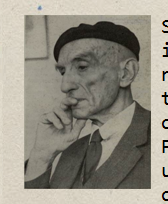
King Johan ca. 1966
The defining moment of Johan's later life occurred in 1958, which started his decline in health. While at his summer house in Grijzestad (11 June), the king slipped and fell down the stairs, which left him in bed for several days, and requiring the use of a cane for several months. Crown Prince Marten and Princess Alexandra were quickly recalled from his posting, where they would represent the monarchy in his stead until November.
Johan then relied more on the Crown Prince and Princess to undertake duties, preferring to remain at the palace. He would not travel abroad after 1960, making his last state visit (to Portugal) in April of that year. From 1958 to 1966, Johan was in hospital on five occasion, due to his injuries, chest pains, pneumonia and other ailments. On 11 September 1961 he slipped in his bathtub; while the impact was not as grave as his fall in 1958, it aggravated that one and made his day-to-day life more difficult. Johan was largely confined to a wheelchair and overnight grew old; the man of fine suits in the 1920s and the sharp Head of the Armed Forces of the war years was gone, replaced by an older frail king wearing tweed suits and berets. Alzheimer's set in in the early 1960s, becoming worse as the decade progressed.
Golden Jubilee[]
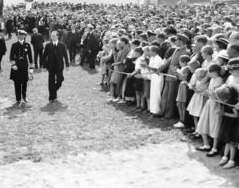
Jubilee festivities in Drenthe
Despite his health issues, the king lumbered on and was seeming better after 1962. That year, planning began towards his golden jubilee, which was occurring in October 1963. The jubilee year opened with the traditional King's New Year's dinner. The new year of 1963 was marked with a fireworks display, the first since liberation in 1944. On 13 April the king marked Liberation Day, the first instance of its commemoration, together with Queen Maria Benedita, the Crown Prince and Princess.
9 June saw the largest Independence Day festivities in many years, but the king was unable to attend due to pneumonia and lung issues. In July he toured Central island, now feeling better, and in September he was well enough to visit Grijzestad and be hosted by dignitaries and nobles there, dine with the mayor of Sint-Anders and further tour Cape Cross, Brezonde and Donderstad.
The week of 21-26 October was the most important of the jubilee year, with most festivities in Koningstad. The actual jubilee date, the 23rd, was marked by a mass in memory of Johan's father, and was capped by a a memorable appearance from the palace balcony, where some 62.000 people had congregated around as part of the festivities. He hosted a dinner for several dignitaries, where all the living prime ministers during his reign were invited (sitting PM Stefan De Vries, Henry Warson, Alexander Bouras and Hans van Loos).
Last years[]
In 1964 his son and daughter in law were named official regents in his stead, effectively marking his stepping down in all but name. On 11 October 1965, Johan and Maria Benedita celebrated their golden wedding anniversary. It was largely a private family affair, but souvenirs were being sold commemorating the couple's 50 years of marriage, and parties were held across the country. Henry Warson, again Prime Minister, visited the king and queen and with his wife presented them with a special bound, unique book on History of Brunant in the Reign of Johan II[11]
The king became increasingly ill in 1966, being hospitalized for chest pains on 17 May, being kept there for four days. 1967 was the hardest year for the king, where his wife began to show early signs of Alzheimer's and injured herself coming out of a car; he was kept entirely to a wheelchair due to increasing pains throughout his body and, according to some sources, was somewhat depressed. He would not leave the palace grounds that year, and he did not undertake any functions as king. Doctors informed his wife and family in September that he would have no more than a few months left, and would likely not make it into 1968. From late October 1967 he was entirely bedridden; 1 November was an especially terrible time, where media reported the king was at his death throes, but by the end of the week had improved somewhat.
Still, he knew his death was near and began asking Prince Marten to seek advice for a way to allow him to formally abdicate. No monarch had ever abdicated out of his own will before, with those removed from power either forced to do so after being deposed (Maria Amalia, Johan) or forced from their throne by the filibuster James Carrington (Pieter I, Adrian II).
Death[]
The king's health quickly deteriorated from 10 November. Few details are known, but it is said when in his conscious moments he would ask for brandy, and kept calling out for his daughter. During a nap in the afternoon of the fifteenth, he died in his sleep.
An official mourning period of five days was proclaimed, and all the flags in the nation flew at half mast. King Johan's coffin laid in state for three days at St. Peter's Church. Several thousand Brunanters came to pay their respect, starting with members of the royal family and Prime Minister Warson. On the morning of 18 November, a requiem was held for the king. An honor guard composed of one man from each military company and naval unit accompanied the carriage carrying Johan's body.
Personal life[]
Impact on sport[]
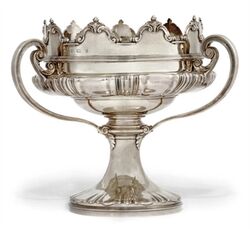
The Johan II Cup (basketball)
Johan has been the royal most connected with sport. He played some rugby and polo in his youth, later taking up tennis in the 1910s, and becoming one of the founders of the Palma Tennis Club in June 1916. Johan strove to promote sport in the country, personally paying for (the trophy) and creating the King's Cup for Horse racing in 1918, the King's Cup for Football in 1930 (forever known as the Johan II Cup), and the King's Cup for Basketball in 1966. Johan loved to go horseback riding with his wife. He owned a stable with nine horses, but his favorite was Pegasus, an Arabian horse given to him by the Sheikh of Sharjah in 1950.
Automobiles[]
King Johan was an avid car owner/driver from early on in his reign. Johan was an amateur race car driver in the early 1910s, much to the chagrin of his mother, racing a Renault car in 1911 and 1912. The King purchased a Dodge sedan in 1918 which would serve them for 11 years. In 1939 he was the first king to have an official state car, a Martell-Werner landau limousine. Among Johan's other vehicles were a 1929 Packard Deluxe Roadster, a 1932 Bugatti Type 55 Roadster and a 1952 Ferrari 212-225.
Issue[]
| Name | Birth | Death | Marriage | ||
|---|---|---|---|---|---|
| Date | Spouse | Issue | |||
| Marten II | 12 June 1923 | 9 October 2011 | 14 May 1948 | Aleksandra Ilava | Anthony (17 July 1951) Princess Marie (2 March 1955) Prince Wilhelm (4 August 1959) |
| Princess Angela Maria | 2 July 1927 | -- | 25 July 1954 | Princess Henrietta (11 May 1956) Prince Hendrik (17 July 1959) | |
Titles, styles and honours[]
Titles and styles[]
- 11 October 1881-23 October 1913: His Royal Highness Prince Johan, Duke of Middleton
- 23 October 1913-15 November 1967: His Majesty The King of Brunant
Ancestry[]
Johan, unlike his successors, came from a background mostly consisting of nobles. The majority were of German (some German-Danish) origin. Some of his other ancestors were Prussian Kings, and he was also related to Tsar Paul of Russia and Empress Maria Theresa of Austria (his grandfather's grandmother).
Ancestors of Johan II
Notes and references[]
- ↑ The next-longest reign was that of Karl Van Draak, at 44 years
- ↑ Not since King Leuvis in the late 15th century has there been a Dutch ancestor to Brunant's monarchs.
- ↑ Marois was a republican anarchist and agitator.
- ↑ Prince Louis was briefly acting king until Johan recovered a week later.
- ↑ The thaler was revalued at 1000 to one in early December 1913.
- ↑ The media made much of Townsend's death in the sinking, further gripping at the hearts of the populace.
- ↑ Private papers suggest she was not happy with the political atmosphere, nor with the air of distrust by some at court or in government for being German and having purported loyalties to the Reich.
- ↑ This was the first coalition government in Brunanter history.
- ↑ While it was very dangerous to listen to the BBC in Brunant and elsewhere, thousands did so, especially as the king was on it.
- ↑ The King Ambroos was built in 1895, was only Brunanter ship at the Otranto Barrage in 1917, and was used in the daring escape to Egypt during the 1941 invasion, carrying the Royal family.
- ↑ An updated edition with the 1965-1967 years became available for sale in July 1968.
